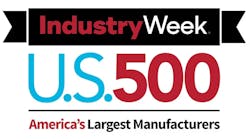Siemens is a company in transition.
The organization has spent the last year neck-deep in a massive, corporate-wide overhaul, realigning its entire 360,000-member manufacturing and engineering workforce to reflect the enormous changes the industry has experienced.
When completed in the next few months, the shift will have directly affected nearly 12,000 workers and will result in new divisions, new departments and a new corporate leaning that seems to have advanced manufacturing clearly in its sights.
Nowhere is this more evident than in the sweeping changes occurring across the Siemens' Industry Group.
In the past, IndustryWeek, has covered the work that department has done to define the digital components driving the "Manufacturing Renaissance" – all of the space-age industrial simulation software and the automation and data-driven tools that have helped manufacturers bounce back from the recession and enter this new, exciting phase of growth occurring in the industry.
But now that group has been split in two – one half covering process industries and drives and the other targeting exactly what this high-tech resurgence is really all about: the Digital Factory.
Running that new division is former Industry Automation Division CEO, Anton Huber – a long-time Siemens leader with some big ideas about technology and the future of advanced manufacturing.
We recently met with Huber to find out a little bit about the changes and where they will help take the industry through the next decade.
Q: Dedicating a department solely to the Digital Factory seems like a dramatic step. Before we get into what it is or how it works, can you tell me why the company decided to make this change?
A: Well, Siemens has reorganized the whole corporation, not just my division. And there were several reasons why things have been moved around.
We are an automation company, historically. We do manufacturing automation, and a lot of our competitors are in manufacturing automation.
But we see that manufacturing automation itself doesn't do the trick anymore.
I mean, of course manufacturers can do more automation. We can always do a little more automation. But it goes into saturation. You end up spending a lot of money for an increment of productivity.
Even if you use TCP/IP protocol in the plant or have whatever in the cloud, it does not really help you to get your stuff out early. And that is really the goal.
To do that, you have to change the whole situation. You have to look holistically at what you do and what you want to accelerate.
So we have changed our perspective and our portfolio of competency because we want to look at the creation of a product from a holistic point of view.
Digital Goals: Simulation, Integration and Implementation
Q: Getting products out faster is the goal? How does the Digital Factory help do that?
A: Getting products out faster is always the goal. We all know that if you are fast, your people are not employed as long, your costs are lower and when you are out early, you get better prices than when you are late and all of the competition has already done all of that.
We look at this in our own plants. We are ourselves a big manufacturer – we have over 200 plants around the world and we see what an advantage it is if you are fast and if you have products out early and at a time when you don't have competition yet.
It's not necessarily about proprietary things, it is a time competition.
Many of the goods produced by [automotive and aerospace suppliers and machine builders] are available from different manufacturers. So they run as fast as they can and if they are the fastest, they have some advantages in the market. And sometimes they are quite significant.
This is what we are working on. We are working on providing technology which allows customers to go to market much earlier with their products, and of course maintain them more competitively when they are out there.
Q: In real terms, though, how do you see the Digital Factory affecting manufacturers? Why are these digital tools so important to the industry?
A: None of this is really new, to be quite honest. We've been hearing since the 1980s that people need product design for manufacturing. It's an old saying in this industry: design for production and design for manufacturing.
But the problems around it still remain.
We see a solution for that in simulation.
Because, how do you check if it is easy to manufacture if you don't have a plant? If you don't have a manufacturing line?
With digitization, simulation is helping here because you don't need a physical plant; you don't need a physical production line.
If you have a good simulation model, then you could simulate how it works when this product goes into production or when this line gets ramped up, where the bottle necks are and so on.
So simulation is a major help in the future. In my view, it is one of the most driving forces in our industry.
But it requires digitization.
Your product has to be availably fully digitally; your manufacturing line has to be available fully digitally. When this is all available, then you can simulate easily.
Basically, it’s a matter of seeing how it works in manufacturing without investing a lot of money into trying it out physically. That can be a major accelerator from our point of view.
Again, that's not really new, but it's very difficult to implement and it costs a lot of money.
Enabling Industry 4.0
Q: It seems like this is all adding up to the kind of connected manufacturing systems we've all been following for the last few years – Industry 4.0 or the Industrial Internet of Things, etc. How does this division and the work you're doing there play into that?
A: Industry 4.0 is a very loosely defined, big thing. You have the Internet, you have ERP, you have everything in the manufacturing environment that helps you do it. It's a huge tent.
That solution is not provided by us as one thing.
Industry 4.0 is basically allowing manufacturers to become, let's say, a flexible and viable part of the Internet economy. Being as fast as it is required, being as connected as it is required.
My job is to provide technology that helps them get there – to help make this Industry 4.0 happen.
Q: A major restructuring – especially a high profile one like this with such lofty ambitions – can't be easy. How are the changes going in your team?
A: Well, restricting is the easiest part, really. That's basically done overnight – people get a new boss and a new mission and this is how they go.
What is much more complicated is to find out what in each and every project has to be done in order to make them on the long term compatible, integrated.
There are a lot of products here that I have to decide today if we should make into a fully integrated tool for supporting the belly-up process.
This is not simple.
Everyone who runs a big company knows that cooperation is not an easy thing in organizations.
This is my challenge.
We are building a unified platform for our whole products line and I have to find out what we can do in the future to build into products to be fully integrated.
However, I believe I have quite an easy job to change my organization.
For our business, it's pretty clear what we want to do: It's digitization. We know where we want to end up – it's basically a digital twin, everything is digitally available. You open your PC and whatever product you look at you can get digital. You can run it, you can simulate it, and you can manufacture it.
So we know what we want to do pretty clearly.
And it needs to be done. It's expensive and fairly complicated, but it's not exactly science. It's not like genetics where you don't know if it works or not. We know this integration can be done and it's not scientifically a question anymore. It is doable, we know how to do it, but we have to pay for it and we have to find the people to do it.
People are excited about this. We are doing a lot of new things, a lot of things where there is no comparison out there. No one did it before.
It's quite some pioneering work. People like to do this.




